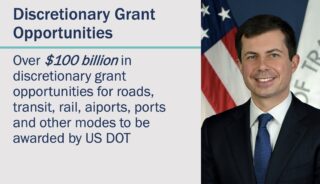
(Photo: Jonathan Maus/BikePortland)
A new infrastructure bill from the White House with a significant amount of new infrastructure funding finally passed on Friday afternoon. Of the $1.2 trillion (with a “t”) in Biden’s bill, about one-quarter of it, or $284 billion will go toward new transportation programs and projects. While elected officials are celebrating, national transportation advocacy nonprofit Transportation 4 America is “far more circumspect”.
The State of Oregon says our share of the federal funds will be about $1.2 billion over the next five years. According to the Oregon Department of Transportation (ODOT), the share of those funds that will go toward “highways” (a broad category of spending that includes most new driving capacity and maintenance on freeways and major highways) is $1 billion and there will be $200 million for “public transportation” (which includes transit, bicycling, walking, and everything not related to increased automobile capacity). Those new funds represent a 38% and 35% funding increase for those two categories.
Based on a presentation shared at the November 3rd meeting of the Oregon Bicycle and Pedestrian Advisory Committee, here’s a further breakdown of where the new money will go:
– Bridges: More than $250 million in additional direct investment in repairing and replacing Oregon’s bridges
– Addressing Climate Change: $52 million to expand availability of electric vehicle charging stations. $82 million for a new Carbon Reduction Program to help achieve our climate commitments
– Resilience: $94 million for a new PROTECT Program to enhance the transportation system’s resilience to disasters, including adapting to climate change
– Safety: More than $40 million in additional funding for the All Roads Transportation Safety (ARTS) Program to make our roads safer for all users
Advertisement
– Local Programs: Significant increases in funding for local governments to invest in community priorities
– Improving Active Transportation: $30 million in additional direct funding for bicycle and pedestrian programs
– Additional Flexible Funding: OTC will decide how to allocate additional flexible federal funds after analyzing outcomes and seeking public input, including from advisory committees
– Public Transportation & Passenger Rail: Nearly $200 million in additional funding for public transportation in rural and urban communities. Significant discretionary grants for passenger rail that could improve the Cascades Amtrak service
– Discretionary Grant Opportunities: Over $100 billion in discretionary grant opportunities for roads, transit, rail, aiports, ports and other modes to be awarded by US DOT

Keep in mind these are still only estimates and there’s a lot of work ahead to determine how exactly the money will be spent. That being said, ODOT has many projects already lined up and there is political and bureaucratic urgency to begin spending this money as soon as possible.
To put this funding into context, ODOT’s annual budget is around $2.55 billion. Of that, 23% comes from the federal government, and 77% from state sources like gas tax, vehicle-related fees, lottery funds, and a few other sources. About one-fifth of ODOT’s budget is allocated to cities, counties, and regions around the state.
In a statement released over the weekend, ODOT said, “The [new Biden infrastructure package] money will go toward projects around the state that will benefit drivers, transit riders, cyclists and pedestrians, help maintain roads and bridges, and address climate change… Many projects are ready for construction… so we should be able to move quickly.”
Oregon Transportation Commission Chair Bob Van Brocklin said in a statement that the funds will allow ODOT to “address a number of major challenges in our state.”
“These resources will help us address congestion, which is increasing in our urban areas as the state’s population continues to grow; freight mobility, earthquake recovery preparedness, passenger rail, and other elements of the comprehensive mobility system we seek to create,” Van Brocklin added.
Stay tuned this week for more coverage of this historic legislation and what it is likely to mean for Oregon’s transportation system.

